Korean Steamed Eggs: The Anytime Dish With A Custard Finish
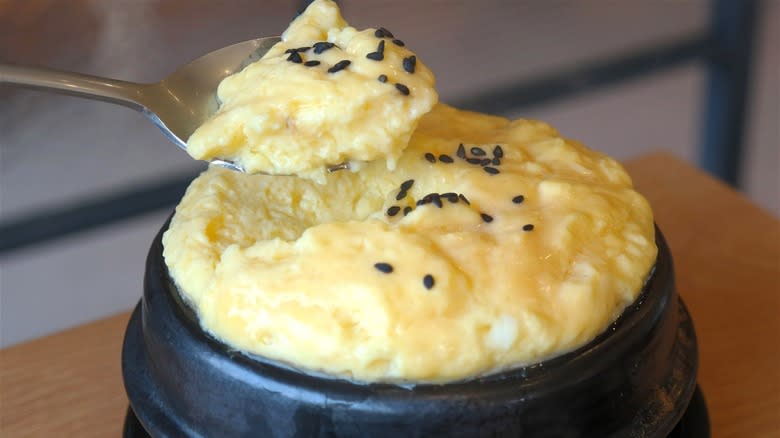
The Korean food scene in the U.S. has really been coming into its own in recent years, perhaps riding the same wave of popularity that has had K-Pop groups surging to the top of the charts. These days, any foodie worth their fleur de sel has both gochujang and gochugaru in the pantry and maybe some instant tteokbokki, as well. Even non-foodies by now may be familiar with Korean dishes such as budae jjigae, bulgogi, and Korean fried chicken, but all of these are entrees. Less well-known is gyeran jjim, a steamed egg dish that is more often served as a side, although it can be eaten with any meal.
Gyeran jjim also goes by a few other names. The "jjim" part refers to a method of cooking that may involve either steaming or braising, with the beef short rib dish galbi jjim being an example of the latter. "Galbi," on the other hand, means "eggs," but so does the word "dalgyal," so another name for the dish is dalgyaljjim. It also has a nickname, that being volcano steamed eggs. This could refer to the fact that the cooked eggs might take on a somewhat cone-like shape but is more likely to be referencing the fact that, steam-cooked as they are, they are likely to release a hot cloud of the stuff when you stick a fork in them.
Read more: Ingredients To Take Your Scrambled Eggs To The Next Level
History Of Korean Steamed Eggs
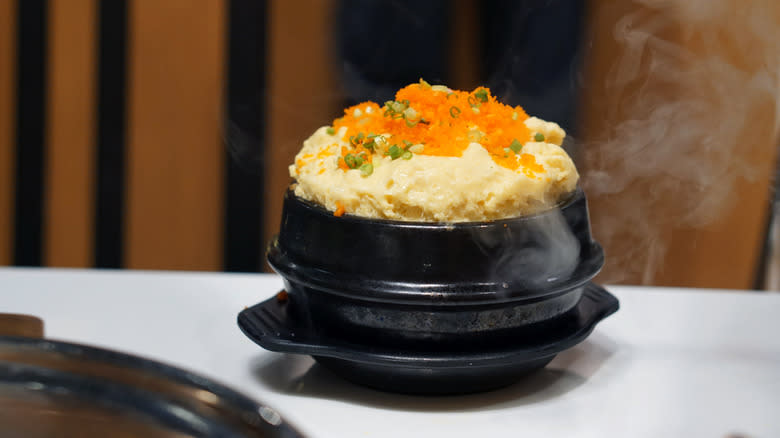
We can't pinpoint with any type of certainty when, where, and how gyeran jjim came to be, but we'll work with what we have. For starters, the ttukbaegi, which is the clay pot in which the dish is traditionally cooked, dates to the Joseon Dynasty. So the dish may not have existed prior to the 14th century (or if it did, would have required a different vessel).
By the 18th century, jjim dishes of some sort were featured on the royal table at both breakfast and dinner, as were some egg dishes, but there is no specific reference of gyeran jjim being among them (or dalgyaljjim, for that matter). All we really know for sure is that it's something that's often described as being traditional, so we'll hazard a guess that it most likely predates the lifetimes of those food bloggers who are writing about it today, especially the ones who are reminiscing about it as being a beloved childhood favorite.
How Are Korean Steamed Eggs Made?
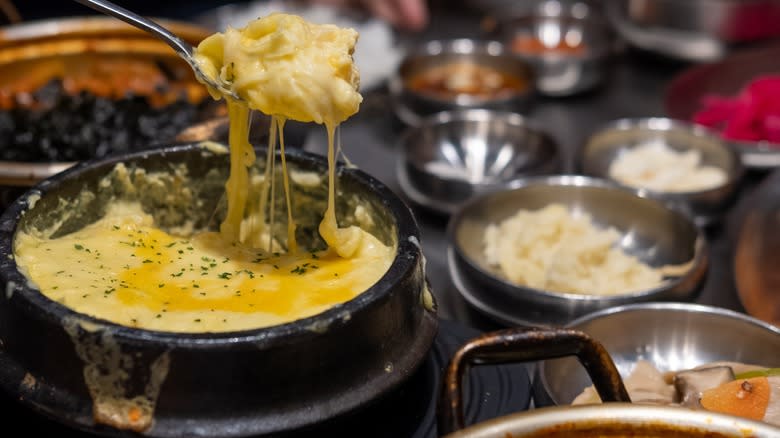
Even though the name of this dish is literally steamed eggs (in English, at least), it's not actually necessary to cook gyeran jjim in a steam bath, much less in a ttukbaegi. In fact, modern Korean cooks may prepare the dish in one of several different ways. One of these, of course, is the steam bath, although a heat-proof baking pan or bowl or individual ramekins can be used in place of an earthenware pot. Another involves cooking it in a covered pot on the stovetop, but the quickest, easiest way may be to "steam" the eggs in the microwave.
The main ingredient is eggs, of course, although these are mixed with a fair amount of liquid — generally about ¼ cup per egg. This liquid can either be water or broth, with anchovy broth being pretty typical, although chicken stock can make for a less fishy flavor. The eggs can also be flavored with mix-ins such as fermented shrimp, dried anchovies, kelp, green onions, fish sauce, sesame oil, sesame seeds, chili oil, chiles, and mirin. One version, known as yeondubu dalgyal jjim, also involves stirring mashed tofu into the eggs before cooking them. Yeondubu is the Korean word for a firm type of tofu and its texture falls in between that of regular dubu, which is extra-firm, and sundubu, which is soft. Other additions that make for a heartier dish may include mushrooms, ground pork, and cheese.
What Do Korean Steamed Eggs Taste Like?
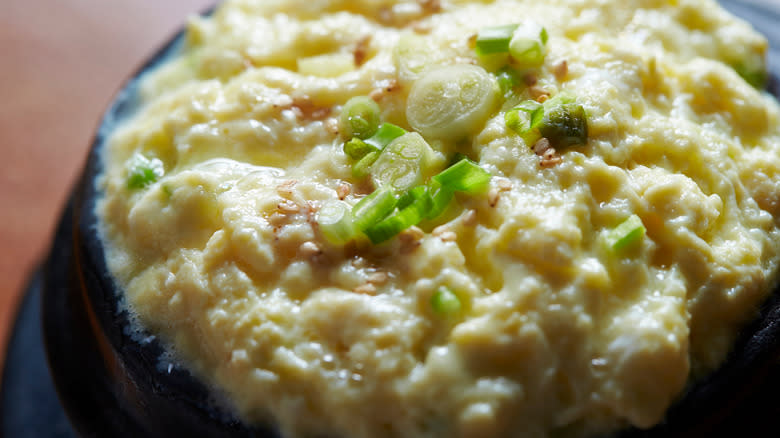
Most of the descriptions of gyeran jjim seem to revolve around texture rather than flavor. Among the adjectives used are fluffy, melty, velvety, and silky, although these last two might seem to contradict each other to some extent as the fabrics, after all, bear little resemblance to one another. Gyeran jjim is also described as steamy, which is something that kind of goes without saying.
As for the flavor itself, some cooks stick with generic words of praise such as delightful, while one especially enthusiastic restaurant, Kuala Lumpur's Kung Jung Korean, refers to a "harmony of flavors." A more useful descriptor, however, might be mild because essentially what you're tasting here is eggs, although the other ingredients will come into play. If anchovy broth is used, the dish may taste fishy, salty, and/or pungent, while chili oil tends to make it spicy. You might as well go ahead and throw in the to a certain extent word umami, too, as this somewhat vague term might apply to the eggs themselves as well as to the flavoring provided by the broth or fish sauce and any add-ins like mushrooms or meat.
Where Can You Find Korean Steamed Eggs?
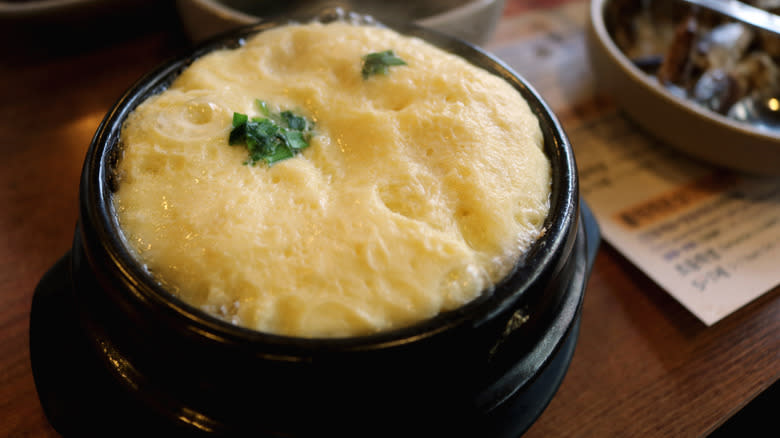
Korean steamed eggs are the kind of thing you are likely to find in numerous Korean homes and restaurants. The dish is also a fixture in Korean school cafeterias, which makes sense as it's both budget-friendly and easy to cook. Assuming you're not in Korea, though, where are you likely to get steamed eggs? From the looks of things on the internet, it seems your very best bet might be to befriend a food blogger who writes about Korean food as it seems to be de rigueur for them to post recipes and videos of this dish. If you can't swing it, though, or else your food blogger friend has already checked off this particular box, you may also be able to find gyeran jjim at a restaurant specializing in Korean barbecue.
Among the places to feature gyeran jjim on the menu are Sol's on the Square in Madison, Wisconsin; Kimchi in Ithaca, New York; Antoya BBQ in New York City's Koreatown; and Bulpan Korean BBQ in Charlottesville, Virginia. At the first two restaurants, the dish is listed as an appetizer, at the third as a lunch entree, but the fourth one does classify it (under the name of dalgyal jjim) as a side dish as is typical for restaurants in Korea.
Read the original article on Mashed.

